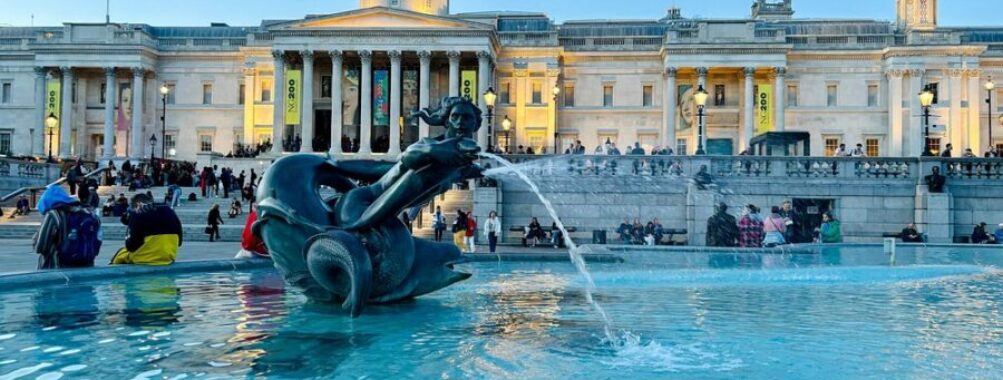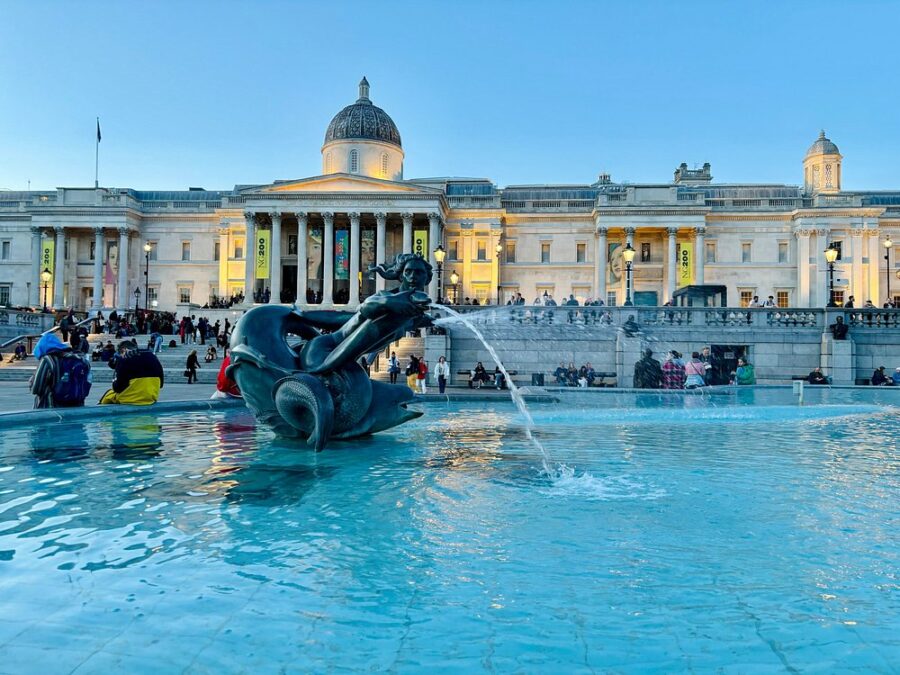
Trafalgar Square
Table of Contents
History and Significance

Trafalgar Square doesn’t just occupy physical space in London—it lives in the British psyche. Created in the 1840s to commemorate Admiral Horatio Nelson’s 1805 victory at the Battle of Trafalgar, this sprawling public space has evolved into something far greater than a memorial. It’s where London celebrates, protests, mourns, and gathers—a stone-paved stage for the nation’s collective drama.
The square’s genius lies in its contradictions. The 52-meter Nelson’s Column, guarded by four massive bronze lions, speaks of imperial might. Yet the fourth plinth’s rotating contemporary art installations—from giant blue cocks to skeletal horses—whisper of a nation constantly re-examining itself. It’s both fiercely British and defiantly international, hosting Chinese New Year celebrations one week and Pride parades the next.
Main Attractions and Activities
The Big Four
-
Nelson’s Column: The naval hero stares eternally toward Portsmouth, where his flagship, HMS Victory, is docked
-
The Lions: Designed by Edwin Landseer, these iconic beasts have weathered everything from victory celebrations to football fans
-
The Fountains: Originally practical horse troughs, now illuminated masterpieces after dark
-
The Fourth Plinth: London’s most controversial art space (currently displaying a sculpture of a black transgender woman breastfeeding)
Cultural Hotspots
-
The National Gallery: Housing masterpieces from Van Gogh to Turner at the square’s north edge
-
St Martin-in-the-Fields: The stunning 18th-century church with lunchtime concerts
-
Canada House/SA House: Architectural gems representing Commonwealth connections
Street Theater
-
Living Statues: The best (and weirdest) buskers in London
-
Political Protests: From climate activists to pension rights marches
-
Spontaneous Celebrations: Where crowds gather for everything from royal weddings to World Cup wins
Visitor Experience
Step into Trafalgar Square and you’re hit with London in concentrated form—the babble of a dozen languages, the shriek of seagulls fighting over chips, the distant hum of black cabs circling. The air carries whiffs of roasted chestnuts in winter, sunscreen in summer, and the ever-present tang of urban life.
The crowd is a perfect London microcosm:
-
Tourists playing chicken with traffic for the perfect lion selfie
-
Office workers sneaking lunchtime sandwiches on the steps
-
Skateboarders testing tricks when the fountains are off
-
Pigeon feeders (despite the ban) covertly scatter seeds
The square’s magic lies in its democratic chaos. One minute you’re admiring a 500-year-old masterpiece in the National Gallery, the next you’re watching a breakdancing troupe or joining a flash mob singing “Hey Jude.”
Tips for Visitors
-
Timing is Everything – Dawn offers magical light on the statues; dusk brings the fountains alive
-
Underground Access – Use Charing Cross station’s back exit to emerge right by the lions
-
Free Wi-Fi – Surprisingly strong signal across the square
-
Comfortable Shoes – Those cobbles look charming, but murder heels
-
Secret Spot – The cafe in St Martin’s crypt has great views without the crowds
-
Safety First – Watch for pickpockets in dense crowds
-
Weather Prep – The square offers zero shelter from rain or shine
Accessibility and Facilities
For a 180-year-old space, Trafalgar Square does remarkably well:
-
Step-free access from multiple points
-
Tactile models of the square for visually impaired visitors
-
Accessible toilets near the café
-
Hearing loops during official events
The public facilities are clean but basic. For proper meals, the crypt café or National Gallery restaurants are your best bets. Avoid the overpriced ice cream vans—a proper gelato shop sits just off St Martin’s Lane.
Unique Features
What makes Trafalgar Square special?
-
The Fourth Plinth – The Most democratic art space in Britain
-
The Time Ball – On Nelson’s Column, drops daily at 1 pm as it has since 1833
-
London’s Smallest Police Station – A barely noticeable booth in the southeast corner
-
The Christmas Tree – Norway’s annual gift since 1947, lit in a ceremony each December
-
The Pigeon Legacy – Though feeding is now banned, their ghosts haunt the square
Overall Impressions
Trafalgar Square is London’s beating heart—a place where history doesn’t sit quietly in books but erupts into daily life. It’s where suffragettes chained themselves to statues, where Londoners celebrated VE Day, and where fans mourned David Bowie. The square holds Britain’s memories in its Portland stone.
You’ll leave with your camera full, your feet tired, and your sense of London’s spirit infinitely richer. It’s not just a tourist stop—it’s where you feel the city’s pulse.
Pros and Cons
Pros
-
Free 24/7 access to one of the world’s great public spaces
-
Perfect central location for exploring London
-
Constant cultural events, from carol singing to political rallies
-
World-class art is just steps away at the National Gallery
-
Excellent transport links with multiple tube stations nearby
Cons
-
It can get uncomfortably crowded during peak times
-
Limited seating (those fountain edges are harder than they look)
-
Aggressive charity fundraisers (“chuggers”) patrol the perimeter
-
No real green space – it’s all hard landscaping
-
Pigeon poop remains an occupational hazard
Trafalgar Square is London in microcosm—grand yet gritty, historic yet constantly evolving. Whether you come for the art, the history, or just to people-watch with a Pret sandwich, it delivers that indefinable London magic.
Location
Places to Stay Near Trafalgar Square
Find and Book a Tour
Explore More Travel Guides
No reviews found! Be the first to review!